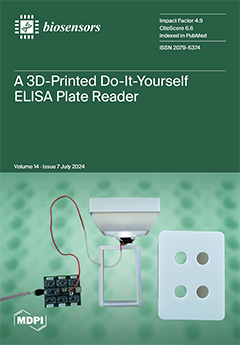A coenzyme A (CoA-SH)-responsive dual electrochemical and fluorescence-based sensor was designed utilizing an MnO
2-immobilized-polymer-dot (MnO
2@D-PD)-coated electrode for the sensitive detection of osteoarthritis (OA) in a peroxisomal β-oxidation knockout model. The CoA-SH-responsive MnO
2@D-PD-coated electrode interacted sensitively with CoA-SH
[...] Read more.
A coenzyme A (CoA-SH)-responsive dual electrochemical and fluorescence-based sensor was designed utilizing an MnO
2-immobilized-polymer-dot (MnO
2@D-PD)-coated electrode for the sensitive detection of osteoarthritis (OA) in a peroxisomal β-oxidation knockout model. The CoA-SH-responsive MnO
2@D-PD-coated electrode interacted sensitively with CoA-SH in OA chondrocytes, triggering electroconductivity and fluorescence changes due to cleavage of the MnO
2 nanosheet on the electrode. The MnO
2@D-PD-coated electrode can detect CoA-SH in immature articular chondrocyte primary cells, as indicated by the significant increase in resistance in the control medium (R
24h = 2.17 MΩ). This sensor also sensitively monitored the increase in resistance in chondrocyte cells in the presence of acetyl-CoA inducers, such as phytol (Phy) and sodium acetate (SA), in the medium (R
24h = 2.67, 3.08 MΩ, respectively), compared to that in the control medium, demonstrating the detection efficiency of the sensor towards the increase in the CoA-SH concentration. Furthermore, fluorescence recovery was observed owing to MnO
2 cleavage, particularly in the Phy- and SA-supplemented media. The transcription levels of OA-related anabolic (
Acan) and catabolic factors (
Adamts5) in chondrocytes also confirmed the interaction between CoA-SH and the MnO
2@D-PD-coated electrode. Additionally, electrode integration with a wireless sensing system provides inline monitoring via a smartphone, which can potentially be used for rapid and sensitive OA diagnosis.
Full article






